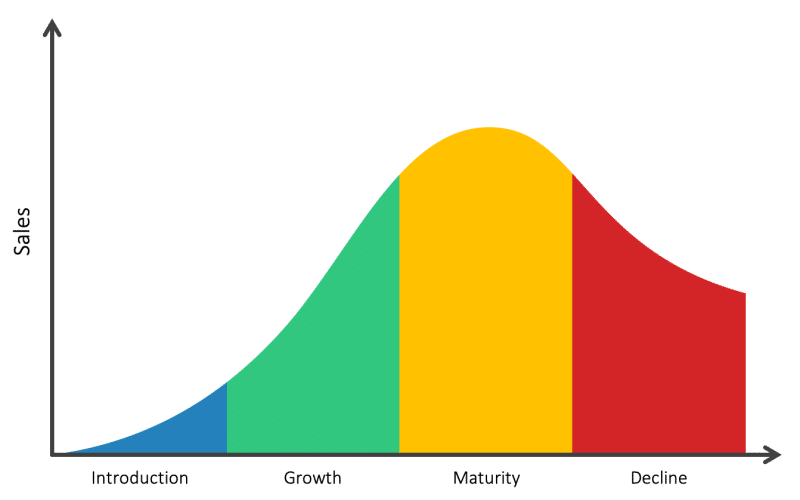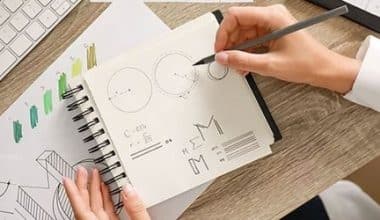For every single day within the year, consumers purchase millions of products. These products, like ourselves, have a life cycle. Older, well-established products gradually lose favor, whereas demand for newer, more modern goods normally rises quickly once they are introduced.
Because most businesses recognize the many stages of the product life cycle and that the items they sell all have a limited lifespan, the majority of them will invest extensively in new product development to ensure that their businesses continue to expand. Let’s see the four stages of the product life cycle and their real-world examples in this post.
What is the Product Life Cycle?
The Product Life Cycle (PLC) describes the stages that a product goes through in the marketplace as it enters, establishes itself, and exits. To put it another way, the product life cycle explains the stages that a product is expected to go through. Managers can use it to examine and build plans for their products as they enter and depart each stage.
What are the Product Life Cycle Stages
The product life cycle is divided into five distinct stages according to Theodore Levitt. Each stage has its own set of characteristics that imply different things to businesses attempting to manage the life cycle of their own products. The five stages in the product life cycle are as follows:
- Development
- Introduction
- Growth
- Maturity
- Decline
#1. Development Stage
The first stage of the product life cycle is usually a delicate period. This is the point where you enhance your plan, conduct tests, validate your suggestions, and make the relevant changes.
The above may be part of your startup process, but it is not exclusive to them. Promotion begins at the development stage and this means the company must design various means of promoting its product before it is introduced.
#2. Introduction Stage
The introduction stage of the cycle may be the most costly for a corporation to release a new product. Because the product’s market is tiny, sales are minimal, albeit they will increase in the future. On the other hand, the costs of things like R&D, consumer testing, and marketing required to launch the product can be very high, especially if it is in a competitive field. There are two price-setting strategies in the introduction stage:
- Price skimming: The practice of charging a high beginning price and progressively lowering (“skimming”) the price as the market increases.
- Price penetration: Establishing a cheap price to quickly enter the market and acquire market share before raising prices in relation to market growth.
#3. Growth Stage
The growth stage is often characterized by rapid increases in sales and earnings, and because the company can begin to benefit from economies of scale in production, profit margins and overall profit will rise. This allows organizations to invest more money in promotional activities to leverage the potential of the growth stages of the product life cycle.
#4. Maturity Stage
During the maturity stage, the product has been established, and the manufacturer’s goal is now to sustain the market share they have gained. This is most likely the most competitive moment for most items, and businesses must invest wisely in any marketing they do. They must also examine any product alterations or upgrades to the manufacturing process that may provide them with a competitive advantage.
#5. Decline Stage
At some point, the market for a product will begin to contract, and this is referred to as the decline stage. This shrinkage could be the result of the market becoming saturated (i.e., all of the customers who will buy the product have already purchased it), or it could be the result of consumers migrating to a different sort of goods.
While this decline may be unavoidable, organizations may still be able to profit by transitioning to less-expensive manufacturing processes and cheaper markets. Numerous strategies can be used throughout the decline period, for example:
- Reduce marketing efforts and try to extend the product’s life as long as possible ( called milking or harvesting).
- Reduce distribution routes gradually and pull merchandise from underperforming geographic areas. A plan like this allows the corporation to pull the product and try to introduce a replacement product.
- Selling the goods to a specialized operator or subcontractor. This enables the corporation to get rid of a low-profit product while keeping its loyal customers.
Summary of the Product Life Cycle Stages
The stages of the product life cycle and common characteristics are summarized in the table below.
| Product life cycle stage | Common Characteristics |
| #1. Stage of market introduction | 1. The costs are really significant. 2. To begin with, sales volumes will be low. 3. There is little or no competition 4. It is necessary to generate demand. 5. Customers must be encouraged to test the goods. 6. At this point, he is making very little money. |
| #2. Stage of Growth | 1. Costs are lowered as a result of economies of scale. 2. The amount of sales has increased dramatically. 3. Profitability starts to rise. 4. The general public’s knowledge grows 5. With a few new companies entering the market, competition begins to heat up. 6. Price reductions occur as a result of increasing competition. |
| #3. Maturity stage | 1. Costs are reduced as a result of increased production volumes and curve effects. 2. Sales volume peaks, and the market is saturated. new market entrants arrive at this stage in the product life cycle 3. Prices tend to fall as a result of the expansion of competing items. 4. To retain or expand market share, brand uniqueness and feature diversification are encouraged. 5. Profits are declining. |
| #4. Decline stage | 1. Costs rise as a result of some loss of economies of scale. 2. Sales volume is decreasing. 3. Prices and profitability are declining. 4. Profit becomes a function of production/distribution efficiency rather than increased sales. |
Customer demand for certain items can provide some very interesting product life cycle stages examples if you look at patterns in key markets over the last couple of decades, or even just the last few years.
Examples of the Stages of Product Life Cycles
The typical product life cycle curve is divided into four distinct stages. Products move through the Introduction stage before entering the Growth stage. Maturity follows, and the product eventually enters the Decline stage. Various examples go into greater information about these stages for certain markets.
#1. 3D Televisions:
Although 3D has been around for a few decades, it is only now, following significant investment from broadcasters and technology companies, that 3D TVs are available for the house, offering an excellent example of a product in the Introduction Stage.
#2. Blue Ray Players:
With advanced technology providing the best viewing experience, Blue Ray equipment is currently seeing a steady increase in sales that is characteristic of the Growth Stage.
#3. DVD Players:
Since their introduction a few years ago, makers of DVDs and the equipment required to play them have amassed a sizable market share. However, they must still deal with the obstacles posed by other technologies, which are typical of the Maturity Stages of the product life cycle.
#4. Video Recorders:
While VCRs may still be purchased, they are clearly in the Decline Stage, since it has become easier and less expensive for consumers to migrate to other, more current formats.
Another example from the consumer electronics sector highlights the introduction and growth of new technology, as well as what may be the beginning of the end for those that have been there for a while.
#1. Holographic Projection:
A relatively new market entry, holographic projection technology allows consumers to transform any flat surface into a touchscreen interface. This is another fantastic illustration of the first stage of the cycle, with a large investment in research and development and high prices that will only appeal to early adopters.
#2. Tablet PCs:
As this product enters the growth stages of the life cycle and more competitors begin to enter a market that really grew after the launch of Apple’s iPad, there is an increasing number of tablet PCs for consumers to choose from.
#3. Laptop computers
Laptop computers have been around for a while, but more advanced components, as well as numerous features that appeal to different parts of the market, will assist to sustain this product as it progresses into the Maturity stage.
Typewriters and even electronic word processors have relatively limited capability. With consumers demanding a lot more from the electronic equipment they buy, typewriters are nearing the end of their commercial product life cycle stages.
It is possible to present examples of numerous goods to better demonstrate the various stages of the product life cycle. Here’s an example of watching recorded television, as well as the many stages of each method:
- Introduction: 3D Televisions
- Growth: Blueray discs and DVRs are on the rise.
- Maturity DVD
- Decline: videocassette
Benefits of Product Life Cycle
The following are some of the benefits of product life cycle management to businesses;
- It keeps and improves your product’s appeal, reputation, and consumer loyalty.
- Product life cycle increases the return on investment of new product launches
- Businesses can also use it to make informed decisions about their products.
- It also increases the company’s profitability
- It proactively adjusts your marketing messages to keep in touch with your target audiences.
What Happens When a Business Fails to MAximize The Product Life Cycle?
The following are some of the challenges that businesses will face when they fail to maximize the use of their product life cycle;
- The business will likely spend too much on its inventory.
- The product may not live up to its potential
- They will have to face the problem of reduced profit
- Entry into the market decline stage at an early stage
The Importance of the Product Life Cycle
A crucial tool for managers, designers, and marketers alike is the product lifecycle. It outlines the four distinct stages of a product’s life cycle and provides recommendations for creating strategies to make the most of each stage and advance the overall commercial success of the product.
What Traits Does the Product Life Cycle Have?
Introduction, growth, maturity, and decline are the four stages that make up a product’s life cycle. Professionals in management and marketing use product life cycles to assist them to decide on advertising schedules, and price points, expanding into new product markets, redesigning packaging, and more.
What Effects Does the Product Life Cycle Have?
The development of a product from its conception until its discontinuation is known as its life cycle. The cycle goes through four stages: development, growth, maturity, and decline. The product life cycle assists entrepreneurs in managing sales, setting prices, forecasting profitability, and competing with other companies.
Which Phase of the Product Life Cycle Is Most Crucial?
The Maturity Phase typically yields the highest profits. The product is currently widely accessible, production costs are low, and marketing expenses are decreasing. When a product reaches this stage, the company making it needs to have recovered the time and money invested in its development thus far.
Conclusion
Product lifecycle management is a concept that has been around for a while, and it is an important notion that manufacturers must understand to make a profit and stay in business.
The key to successful manufacturing, however, is not only recognizing this product life cycle but also proactively managing products throughout their existence, using the necessary resources and sales and marketing tactics based on where items are in the stages of the cycle.
While it is typically left to manufacturers and marketers to worry about Product Life Cycle Management and the ramifications the various stages may have for their business, considering actual items is a smart method to illustrate to customers the role they play in this life cycle.
FAQs On Product Life Cycle Stages
What is an example of a product in the growth stage?
There are various products currently at their growth stages. Some of this is a cryptocurrency, the Internet is a current, ongoing building project, and so on.
What are examples of products in the decline stage?
The decline stage of a product is the stage at which its demands have drastically reduced. Sony VCRs are an example of one such product at its stage.






